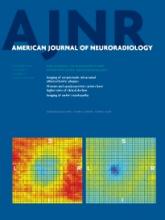Abstract
BACKGROUND AND PURPOSE: Age and the apolipoprotein E ε4 allele are well-known risk factors for Alzheimer disease, but whether female sex is also a risk factor remains controversial. It is also unclear how these risk factors affect rates of structural brain and clinical decline across the spectrum of preclinical to clinical Alzheimer disease. Our objective is to estimate the effects of apolipoprotein E ε4 and sex on age-specific rates of morphometric and clinical decline in late-onset sporadic Alzheimer disease.
MATERIALS AND METHODS: With the use of linear mixed-effects models, we examined the effect of age, apolipoprotein E ε4, and sex on longitudinal brain atrophy and clinical decline among cognitively normal older individuals and individuals with mild cognitive impairment and Alzheimer disease (total = 688). We also evaluated the relationship between these effects and CSF biomarkers of Alzheimer disease pathology.
RESULTS: Apolipoprotein E ε4 significantly accelerated rates of decline, and women in all cohorts had higher rates of decline than men. The magnitude of the sex effect on rates of decline was as large as those of ε4, yet their relationship to measures of CSF biomarkers were weaker.
CONCLUSIONS: These results indicate that in addition to apolipoprotein E ε4 status, diagnostic and therapeutic strategies should take into account the effect of female sex on the Alzheimer disease process.
ABBREVIATIONS:
- AD
- Alzheimer disease
- ADAS-Cog
- cognitive subscale of the Alzheimer Disease Assessment Scale
- ADNI
- Alzheimer's Disease Neuroimaging Initiative
- APOE
- apolipoprotein E
- CDR-SB
- Clinical Dementia Rating Scale, sum of boxes
- HC
- cognitively healthy elderly
- MCI
- mild cognitive impairment
- MMSE
- Mini-Mental State Examination
- NFT
- neurofibrillary tangle
- p-τ
- phosphorylated τ
- © 2013 by American Journal of Neuroradiology
Indicates open access to non-subscribers at www.ajnr.org







